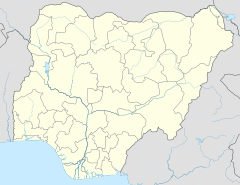Foge Islands
| Foge Islands | ||
|---|---|---|
|
|
||
| Location: | Nigeria | |
| Specialty: | Niger State , Kebbi | |
| Next city: | New Bussa | |
| Surface: | 42.2874 km² | |
| Founding: | 2008 | |
The Foge Islands are a protected area under the Ramsar Convention in the Nigerian states of Niger and Kebbi . It occupies an area of 42.2874 km² in the Kainji Reservoir at an average height of 150 meters above sea level. On April 30, 2008, it was included in the Ramsar Convention's list of wetlands of international importance. It is considered to be a significant wetland in the Sudan's ecoregion . It is under the administration of the environmental and agricultural departments of the two states. It is classified as Category II: National Park by the IUCN , as the protected area is part of the Kainji National Park .
The Foge Islands are located approx. 45 km upstream of the dam of the Kainji reservoir and consist of the main island Foge Island and two smaller islands or sandbanks, which are off the main island to the north. The islands are characterized by flat terrain and their size changes depending on the season. The year-round protruding island area over the waterline is less than five km². The highest peaks are termite mounds . The soils of the islands are known as alluvial alluvial soils , as the islands in the middle of the Niger River were formed by sedimentation , especially during the flood season. This starts from July and is called the white tide because of the high sediment load that the Niger carries with it . From December to February the flood is called the black flood , because the water of the Niger then carries less sediments and appears much clearer and more transparent. The highest water level in the Kainji Reservoir is reached in October, and it drops continuously until July, when the water level is lowest.
The climate in the region is known as tropical humid , with a pronounced separation of rainy and dry periods, with the lowest mean daily temperatures in December / January of 16 ° C and maximum temperatures in March / April of 38 ° C. The rainy season extends from May to October and is determined by the precipitation regime of the West African monsoons . The average annual rainfall is around 1018 mm.
The islands, which used to be overgrown with dense forest, were cleared before the flooding of the Kainji reservoir and are now covered with a mixture of grass savannahs and wetland vegetation, which is criss-crossed by smaller canals. Typical representatives of the wetland vegetation are Nymphaea lotus , Echinochloa pyramidalis , Echinochloa stagnina , Cyperus papyrus , Vossia cuspidat and barnacles ( Echinochloa ). The grass savannahs are dominated by grasses of the genera Hyperthelia , Hyparrhenia and Andropogon . Citrus plants , mango and guavas are also grown on the inhabited main island .
Foge Iceland is an important breeding ground for the Witwenpfeifgans ( Dendrocygna viduata ), the blue-cheeked bee-eater ( Merops persicus ), the Collared Pratincole ( Glareola pratincola ) and Spornkiebitz ( Vanellus spinosus ). Other frequently observed representatives of the avifauna are the brown sickler ( Plegadis falcinellus ), the spur goose ( Plectropterus gambensis ), the pintail ( Anas acuta ) and the African darter ( Anhinga rufa ).
Individual evidence
- ↑ The Annotated Ramsar List: Nigeria ( Memento of October 12, 2013 in the Internet Archive ) (English)
- ↑ Kainji Lake National Park ( Memento of the original from April 30, 2013 in the Internet Archive ) Info: The archive link was automatically inserted and not yet checked. Please check the original and archive link according to the instructions and then remove this notice. on Nigerian National Park Service (English)
- ↑ OGUNKOYA & Dami: Information Sheet on Ramsar Wetlands (RIS) - 2006-2008 Version ( Memento of the original from November 4, 2013 in the Internet Archive ) Info: The archive link was inserted automatically and has not yet been checked. Please check the original and archive link according to the instructions and then remove this notice. on Wetlands.org (PDF document; 115 kB) (English)
- ↑ THE Kainji Lake publication of the FAO (English)
- ↑ Dr. JSO Ayeni and M. Mdaihili: ALTERNATIVE INCOME iN KAINJI LAKE AREA Nigerian-German Kainji Lake Fisheries Promotion Project (PDF document; 478 kB) (English)
